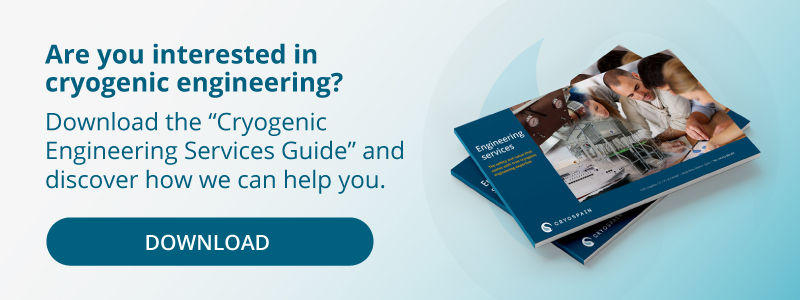Compressed hydrogen stands at the center of a revolution that is taking the transport industry and other sectors by storm.
However, the lack of storage solutions for this substance and cryo hydrogen have long remained one of the key obstacles for this development.
Access to an efficient cryo compressed hydrogen tank is thus the key to unlock developments regarding this substance, which include the possibility of carbon neutrality thanks to greener transportation and fuel options based on hydrogen.
What is compressed hydroge? What is the difference with cryo compressed hydrogen? How can companies embrace the use of this substance in a safe and efficient manner? From our experience in cryogenic engineering, at Cryospain we share this short guide about compressed hydrogen.
Basic details about compressed hydrogen
Compressed hydrogen (CGH2, CH2 or CGH2) is hydrogen at its gaseous state but kept under pressure, typically at 350 bar (5,000 psi) and 700 bar (10,000 psi).
This substance thus simplifies the issue of storing hydrogen, as this element in its gaseous state presents an excessively low density, which meant tank sizes needed to be enormous posing not only logistical but also safety issues.
On the other hand, cryo compressed hydrogen is kept at cryogenic (-150º) temperatures, and presents a higher hydrogen density, thus pushing the storage possibilities further.
Related content: Liquid hydrogen storage: learn the basics
Storing compressed hydrogen
While storing hydrogen has always represented a challenge, the discovery of efficient methods for it is boosting the so-called “hydrogen economy”. In fact, a number of options are being investigated today in search for the right one.
At this point, the physical storage of compressed hydrogen in tanks stands out as the technology facilitating onboard automotive storage. Pressure values here remain between 350 and 700 bar (5,000 and 10,000 psi).
Cryogenic hydrogen VS. Cryo-compressed hydrogen storage
The main difference would be developing a storage solution that is able not only to generate cryogenic temperatures, but also can be pressurized at nominal pressure levels of between 250-350 atm.
Industrial uses of compressed hydrogen
- Aerospace and aircraft industry: it is using the possibilities of compressed hydrogen as a power source in rockets and other life-support equipment.
- Automotive & Transportation industry: used as an alternative fuel, compressed hydrogen is facilitating the move towards greener transportation. It presents a clean combustion (hydrogen-powered vehicles only emit water and water vapor).
- Metal industry: welding and metal manufacturing processes employ hydrogen for cutting operations and welding stainless steel, among other options.
- Refineries: compressed hydrogen helps turning crude oils into refined fuels
- Electronics industry
- Food and beverages
- Chemicals
- Pharmaceutical and medical industry

Tips for a safe handling of compressed hydrogen
Gas plant maintenance programs represent a basic feature to guarantee the storage of compressed hydrogen and cryo compressed.
In fact, safety measures regarding these substances must guarantee all their potential hazards (mainly flammability and explosivity) are covered and dealt with.
Additionally, there are a number of measures and tips that must be followed in order to safely handle compressed hydrogen:
- Gas cylinders must be kept at an upright position, secured and protected against heat and direct sunlight, as well as separated from oxidizing gases. They also shouldn’t be rolled over, dropped or lifted using their protective valve caps
- Regulators must be adapted to use with hydrogen. These should be replaced with protective valve caps before moving gas cylinders
Keep reading: Revolutionizing the aeronautical industry with liquid hydrogen
- Cylinders mustn’t be cracked to perform cleaning operations, as there’s a risk of self-ignition.
- Potential hydrogen leaks must be checked periodically. Adequate ventilation is also advisable to eliminate small leaks, as well as gas detection alarm systems.
- Potential ignition sources should be eliminated while handling compressed hydrogen
All in all, human teams in charge of compressed hydrogen equipment must be trained to respond to potential safety issues such as:
- Knowing which emergency contacts to make and who must be notified
- Being able to activate emergency evacuations
- Knowing when and how to shut off hydrogen sources
- Knowing when and how to put off small hydrogen fires. Some fires might burn themselves out, while if they’re snuffed out they might be reignited. Water fire extinguishers are only advisable if the human team has been trained to use them. However, a venting hydrogen flame will not be extinguished with water.
All in all, having access to adequate, high-quality hydrogen storage solutions remains the key to guarantee safety. On the other hand, correct maintenance programs also play a significant role in detecting issues before they turn into safety problems.
At Cryospain, we offer cryogenic, pressurized storage solutions as both top-of-the-line single and double containment systems. Additionally, our equipment can be customized in order to employ different dimensions, materials or insulation systems.
At the same time, we’re proud to be able to offer end-to-end service tailored to each client’s unique needs, including preventive and predictive maintenance plans.
These include periodic inspections as well as potential repair operations for cryogenic and pressure equipment, providing a 360º service that follows ITC EP4 and ITC EP6 guidelines.
Among the common operations to guarantee compressed hydrogen equipment runs efficiently and safely, we perform: pressure tests, valve checks and level A, B and C inspections.
We’re also able to respond to urgent corrective maintenance needs, replacing components so that equipment can be safely kept in operation at all times. Want to learn more about compressed hydrogen and the current possibilities to store it guaranteeing safety and efficiency? Get in touch with us and talk to our team about how we can help you.











 Contacte-nos
Contacte-nos